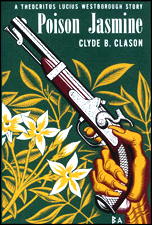Thu 16 Jul 2009
CLYDE B. CLASON – Poison Jasmine.
Doubleday Crime Club, hardcover, 1940. Trade paperback reprint: Rue Morgue Press, 2008.

Poison Jasmine involves murder among perfume manufacturers. While other Clason mysteries are set among art collectors, Poison Jasmine has a background of science and technology, instead.
It is a scientific detective story. The main crimes involve poisoning, and these too are scientific in nature. The science in Poison Jasmine often involves plants; Clason’s knowledge of botany will return in Green Shiver.
Sleuth Theocritus Lucius Westborough has much information on perfumery in the ancient world. Poison Jasmine is also one of Clason’s books in which Westborough’s career as a classical historian is best integrated into the novel.
The book’s look at a business as a background for a crime also resembles Rex Stout. As in Stout, we have a group of suspects that work as officers and consultants for a small, successful business. They are upper middle class, educated people of considerable business skill. Stout’s businesses tend to have an intellectual feel, such as a design firm, publishing or broadcasting. Clason’s perfume firm is steeped in cultural traditions of the world of scent production.
Unlike some other Clason works, Poison Jasmine does not recreate another culture. It does offer a sympathetic, anti-racist account of the Chinese chef, which is in accord with the views expressed in Clason’s other fiction.
Poison Jasmine has a simple, but effective impossible crime puzzle; in fact, it anticipates ideas John Dickson Carr will use in one of his later novels. The book also shows Clason’s flair for color imagery. Both the flowers, and events of the mystery plot, are described in color terms.
Agatha Christie in The Big Four (1924) included a section called “The Yellow Jasmine Mystery” (Chapters 9-10). This deals with the same poisonous plant that gives the title to Poison Jasmine.
Poison Jasmine seems padded. Like many mystery novels, it would have been better as a novella. Most of the meat of both the mystery plot and perfume background are in several sections totaling around seventy pages.
Editorial Comment: If you’re looking for a copy of this book to read, you will need a lending library that never has discarded a mystery novel in the past 70 years. Either that, or take advantage of Rue Morgue Press’s highly laudable policy of getting hard-to-find vintage mystery fiction back into print. There was only one copy of this book on ABE just now when I looked, and in dust jacket the asking price was in the $300 range.
For a long overview of Clyde B. Clason’s life and writing career, the Rue Morgue website is also the place to go.
Coming up soon: Bill Pronzini’s review of Clason’s Blind Drifts (Doubleday, 1937), taken from 1001 Midnights, then my own of Murder Gone Minoan (Doubleday, 1940).